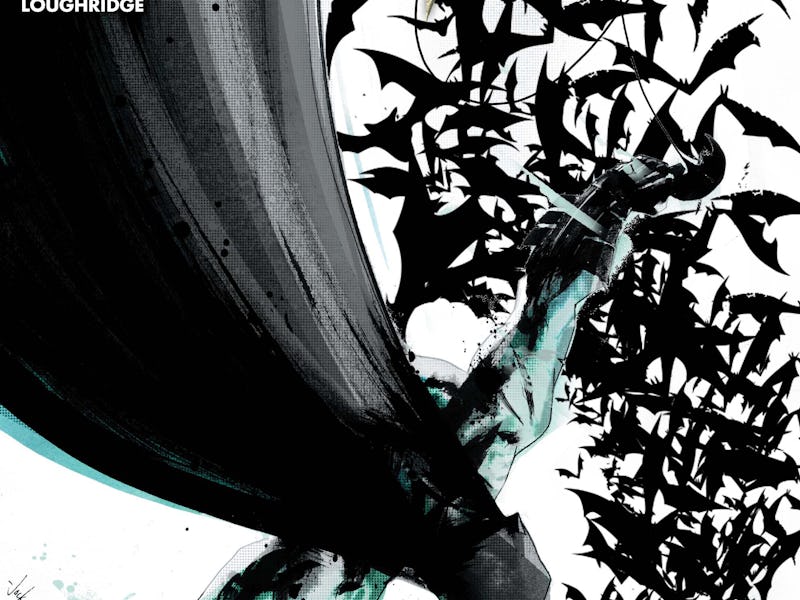'Batman #44' and Comic Books Serving Social Justice
Batman's recent rage against the machine isn't a trend. It's tradition.

At first glance, comic books might seem like an unlikely place for progressive social politics. But as it turns out, it’s always been a tradition.
The newest issue of Batman, Scott Snyder’s Batman #44, has made headlines for its socially-conscious premise that begins with a flashback to a younger Batman (Bruce Wayne, the Dark Knight is otherwise Commissioner Gordon at the moment) investigating the death of a black teenager named Peter, shot by a white GCPD officer and chillingly “left for the crows.”

Dressed in a hoodie not unlike Trayvon Martin, 'Batman #44' evokes troubles of this time for narrative purpose.
Peter isn’t killed by the officer’s gunshot, it should be noted. Peter fell to his death after drinking a potion that Batman’s newest villain, Mr. Bloom, gave him to heal from his wounds. Peter sprouts batwings as a result from Mr. Bloom’s serum and falls to his death. (Don’t forget this is still a comic book.)
From 'Batman #44,' written by Scott Snyder.
Fans inexplicably splinter when their spandex heroes are written into dealing with the same IRL problems that occur right around their own city block. Some praise it, some find it unbearable. “Good job DC. Way to pile on” reads a comment on the Rolling Stone’s coverage of the Batman comic.
Good job indeed, and they should be used to it by now. “Piling on” has been happening in mainstream comics for decades.
In 1970, illustrator and author Neal Adams and Dennis O’Neil, under the leadership of DC Comics editor Julie Schwartz, turned in one of the defining comics of the Bronze Age: Green Lantern/Green Arrow.
For over a dozen issues, cosmic cop Green Lantern — a well-intentioned, loyal, but naive soldier with a strong U.S. military background — is brought back down to Earth by the streetwise Green Arrow, a bastion of progressive politics to show him there are bigger problems than evil space aliens. Poverty, drugs, racism, and class and social discrimination are happening, and Lantern would know it if he weren’t flying around smiling all the time. Despite the green spandex, the two heroes could not have been more different.
Although the American Civil Rights Movement had “ended” by roughly 1968-1969, the struggle for social equality is a never-ending fight and in 1970 it was still ripe for exploration. Hoping to challenge readers — old enough to know but young enough to figure it out for themselves, Adams and O’Neil wrote the Green Arrow dragging the Green Lantern on a cross-country road trip to see exactly who lives on the planet the Green Lantern spends his energy defending.
For Hal Jordan, the experience was a major reality check.
The HIV and AIDS epidemic plagued the United States in the ‘80s and ‘90s. The diseases were found to have had some root in the gay communities of Los Angeles, San Francisco, and New York, which profoundly affected the social outcasting and lambasting of LGBT — and superheroes had a few things to say about it.
In 1993, Marvel’s X-Men — a thinly veiled allegory for minority groups seeking equality — battled the Legacy Virus, a strain that weakened healthy cells in mutants and eventually spread to non-mutants as well. “Absolutely as creators,” X-Men writer Fabian Nicieza is quoted in Joseph J. Darowski’s X-Men and the Mutant Metaphor: Race and Gender in the Comic Books, “having gone through our 20s in the ‘80s we were well-informed by the thematic underpinnings of prejudice against gays as a result of the virus outbreak.”
“The whole underlying principle of the X-Men was to try to be an anti-bigotry story to show there’s good in every person,” said creator Stan Lee at a convention in 2013.
Several years after 9/11 and well into the Bush administration, Marvel published a major summer crossover event titled Civil War.
Its premise — Should superheroes be registered for federal oversight? — stemmed from post-9/11 paranoia. In the interest of security, how much freedom and independence are we willing to give up?
The looming shadow of the Patriot Act was ping-ponged by Marvel’s heroes, who traded punches as well as intellectual reasoning. This premise is the inspiration for next year’s Captain America: Civil War, although the film will be taking a lot of thematic liberties.
To cover every instance of comic book superheroes championing causes, challenging current ills, and fighting for social justice would leave us here all day. Marvel and DC are far from the only publishers who challenge their moments in time — the independent comics scene is rich with this material — but they arguably reach the biggest audience who could stand to learn it the most.
And really, aren’t all superheroes “social justice warriors”?
This article was originally published on